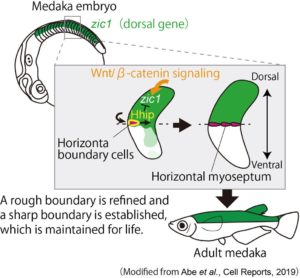Kota Abe 1,2、Atsuko Shimada 1、Sayaka Tayama 1、Hotaka Nishikawa 1、Takuya Kaneko 1、Sachiko Tsuda 3、Akari Karaiwa 4、Takaaki Matsui 4、Tohru Ishitani 2、Hiroyuki Takeda 1 (1. Department of Biological Sciences, Graduate School of Science, University of Tokyo 、2. Department of Molecular Medicine, Institute for Molecular and Cellular Regulation, Gunma University 、3. Division of Life Science, Graduate School of Science and Engineering, Saitama University、4. Gene Regulation Research, Division of Biological Science, Graduate School of Science and Technology, Nara Institute of Science and Technology)
About
Previous studies using Medaka fish revealed that the dorsal and ventral regions of the teleost trunk are divided by a sharp boundary for life. However, mechanisms underlying boundary formation remained elusive. In this study, we identified a novel group of cells, called horizontal boundary cells (HBCs) as crucial players for the boundary formation. HBCs are found to contribute to the horizontal myoseptum, an anatomical structure dividing dorsal and ventral regions of the trunk throughout life. In addition, Hhip expressed in horizontal boundary cells is necessary for the boundary refinement through inhibition of Wnt/β-catenin signaling pathway. This study leads to the understanding of mechanisms underlying formation and maintenance of macro-scale morphologies in animals.
Paper information
Horizontal Boundary Cells, a Special Group of Somitic Cells, Play Crucial Roles in the Formation of Dorsoventral Compartments in Teleost Somite. Kota Abe, Atsuko Shimada, Sayaka Tayama, Hotaka Nishikawa, Takuya Kaneko, Sachiko Tsuda, Akari Karaiwa, Takaaki Matsui, Tohru Ishitani, and Hiroyuki Takeda. Cell Rep. 2019 Apr 16;27(3):928-939.e4.
Online URL
https://www.ncbi.nlm.nih.gov/pubmed/30995487







